Nanoindentation-Based Characterization of Mesoscale Mechanical Behavior in Dolomite Crystals
Abstract
:1. Introduction
2. Materials and Methods
2.1. Testing Principles
2.2. Sample Preparation
- First, a granite core is processed on a cutter to produce a sample approximately 15 mm × 15 mm × 5 mm (length × width × height).
- The sample is sequentially ground on a metallographic grinder using sandpapers with grits of 100, 600, 800, 1000, 2000, 3000, 5000, and 7000. Each grit is used for a minimum of 10 min, with the 7000-grit sandpaper used for at least 20 min to ensure that the sample surface is sufficiently smooth and flat.
- The ground sample is then subjected to sequential graded polishing using different polishing pads and corresponding grades of oil-based diamond polishing slurry, with diamond particle sizes of 6 μm, 1 μm, and 250 nm, respectively. Each polishing stage must last for at least 5 min, and the final polishing stage is the most critical, with a duration of no less than 10 min. Due to the high rotation speed of the polishing pads, it is advisable to apply a uniform external force during polishing to avoid secondary damage to the granite surface. After each polishing step, the sample is ultrasonically cleaned in anhydrous ethanol to ensure that the surface is free of any impurities.
- Finally, the sample is placed in an oven at 50 °C and dried for no less than 24 h to ensure it is completely dry.
2.3. Calibration and Experiment
3. Results and Analysis
3.1. Mineral Composition
3.2. Curve Characteristics and Micromechanical Properties Analysis
3.2.1. Curve Characteristics
3.2.2. Micromechanical Property Analysis
3.3. Analysis of Microstructural Damage Morphology
4. Discussion
5. Conclusions
Author Contributions
Funding
Data Availability Statement
Conflicts of Interest
References
- Parameswaran, V.; Basu, S.; Desai, C.K. Determination of Complex Stress Intensity Factor for a Crack in a Bimaterial Interface Using Digital Image Correlation. Opt. Lasers Eng. 2012, 50, 1487–1495. [Google Scholar] [CrossRef]
- Lothenbach, B.; Winnefeld, F.; Alder, C. Effect of Temperature on the Pore Solution, Microstructure and Hydration Products of Portland Cement Pastes. Cem. Concr. Res. 2007, 37, 483–491. [Google Scholar] [CrossRef]
- Zhu, W.; Bartos, P.J.M. Application of Depth-Sensing Microindentation Testing to Study of Interfacial Transition Zone in Reinforced Concrete. Cem. Concr. Res. 2000, 30, 1299–1304. [Google Scholar] [CrossRef]
- Ollivier, J.P.; Maso, J.C.; Bourdette, B. Interfacial Transition Zone in Concrete. Adv. Cem. Based Mater. 1995, 2, 30–38. [Google Scholar] [CrossRef]
- Griffith, A.A. The Phenomena of Rupture and Flow in Solids. Philos. Trans. R. Soc. Lond. Ser. A 1921, 221, 163–198. [Google Scholar]
- Zhang, M.; Fan, X.; Zhang, Q.; Li, Y.; Liu, J. Parametric Sensitivity Study of Wellbore Stability in Transversely Isotropic Medium Based on Poly-Axial Strength Criteria. J. Pet. Sci. Eng. 2021, 197, 108078. [Google Scholar] [CrossRef]
- Zhang, M.; Li, D.; Liu, J.; Wang, X. The Modification of Mohr-Coulomb Criteria Based on Shape Function and Determination Method of Undetermined Parameters. Mech. Mater. 2023, 185, 104772. [Google Scholar] [CrossRef]
- Dong, Z.; Tian, S.; Xue, H.; Wang, Y. A Novel Method for Automatic Quantification of Different Pore Types in Shale Based on SEM-EDS Calibration. Mar. Pet. Geol. 2025, 173, 107278. [Google Scholar] [CrossRef]
- Wu, W.; Wang, T.; Bai, J.; Liu, J.; Wang, X.; Xu, H.; Feng, G. Failure Characteristics and Cooperative Control Strategies for Gob-Side Entry Driving near an Advancing Working Face: A Case Study. Processes 2024, 12, 1398. [Google Scholar] [CrossRef]
- Ni, H.J.; Guo, X.; Ding, L.; Zhang, Y. Experimental Study on the Effect of Supercritical Carbon Dioxide Immersion on Shale Mechanical Properties. J. China Univ. Pet. (Nat. Sci. Ed.) 2019, 43, 77–84. [Google Scholar]
- Guo, H.Q. Nanoindentation Experimental Study on Granite After High-Temperature Heat Treatment. Master’s Thesis, Hubei University of Technology, Wuhan, China, 2017. [Google Scholar]
- Mao, W.Z. Study on Mesoscopic Mechanisms of Variability in Granite Mechanical Properties. Ph.D. Thesis, Zhejiang University, Hangzhou, China, 2020. [Google Scholar]
- Ji, J.C. Study on Physical-Mechanical Properties and Macro-Micro Mechanical Characteristics of Granite. Master’s Thesis, Anhui University of Science and Technology, Huainan, China, 2019. [Google Scholar]
- Zhang, M.M.; Liang, L.X.; Liu, X.J. Analysis of the Influence of Different Rock Shear Failure Criteria on Wellbore Collapse Pressure. Chin. J. Rock Mech. Eng. 2017, 36, 3485–3491. [Google Scholar]
- Zhang, M.; Fan, X.; Zhang, Q.; Liu, Y. Influence of Multi-Planes of Weakness on Unstable Zones Near Wellbore Wall in a Fractured Formation. J. Nat. Gas Sci. Eng. 2021, 93, 104026. [Google Scholar] [CrossRef]
- Gu, S.T.; Lu, Y.Q.; Li, W.S.; Chen, L. Experimental Study on Meso-Mechanics and Fracture Properties of Coal-Measure Mudstone Based on Nanoindentation. Coal Eng. 2023, 55, 128–133. [Google Scholar]
- Wang, J.W.; Che, M.G.; Song, X.; Li, Z. Evaluation of Rock Mechanical Parameters Using Nanoindentation Technology. J. Shenzhen Univ. (Sci. Technol. Ed.) 2023, 40, 608–614. [Google Scholar]
- Luo, T.Y.; Zhang, Q.S.; Liu, Z.B.; Huang, F. Nanoindentation Experimental Study on Mechanical Characteristics of Red-Bed Mudstone in Hechi, Guangxi. J. Water Resour. Water Eng. 2022, 33, 174–181. [Google Scholar]
- Bai, B. Experimental Study on the Effect of Supercritical Carbon Dioxide on Shale Mechanical Properties. Master’s Thesis, China University of Petroleum (East China), Qingdao, China, 2019. [Google Scholar] [CrossRef]
- Yang, C. Nanoindentation Experimental Study on Physical-Mechanical Parameters of Granite Gneiss. Master’s Thesis, Xi’an University of Technology, Xi’an, China, 2020. [Google Scholar] [CrossRef]
- Zhang, Z.H. Numerical Simulation Study on Granite Nanoindentation Experiments and Mechanical Parameter Upscaling. Ph.D. Thesis, Xi’an University of Technology, Xi’an, China, 2023. [Google Scholar]
- Cai, Y.D.; Jia, D.; Qiu, F.; Wang, L. Analysis of Microscopic Mechanical Characteristics and Influencing Factors of Coal-Rock Based on Nanoindentation. J. China Coal Soc. 2023, 48, 879–890. [Google Scholar]
- Jiang, J.D.; Shen, J.Y.; Hou, D.W. Fracture Toughness Measurement and Calculation Method of Calcium Silicate Hydrate Based on Nanoindentation. J. Chin. Ceram. Soc. 2010, 46, 1067–1073. [Google Scholar]
- Xie, X.H.; Deng, H.C.; Hu, L.X.; Li, Q. Investigating the Influence of Shale Laminae Structure on Micro-Macro Mechanical Behavior Through Nanoindentation and FE-SEM Techniques. Geol. Rev. 2024, 70, 319–322. [Google Scholar]
- Liu, Z.J.; Huang, M.; Cui, M.J.; Zhang, R. Study on Microscopic Mechanical Characteristics of MICP-Cured Shale Soil Using Nanoindentation Technology. J. Disaster Prev. Mitig. Eng. 2022, 42, 1036–1045. [Google Scholar]
- Zhang, Z.P.; Zhang, S.C.; Shi, S.Z.; Liu, H. Evaluation of Multiscale Mechanical Properties of Conglomerate Using Nanoindentation and Homogenization Method: A Case Study of Tight Conglomerate Reservoirs in the South Slope of Mahu Sag. Chin. J. Rock Mech. Eng. 2022, 41, 926–940. [Google Scholar]
- Kalei, G.N. Some results of microhardness test using the depth of impression. Mashinovedenie 1968, 4, 105–107. [Google Scholar]
- Lei, M. Study on Hydrochemistry and Meso-Mechanical Characteristics of Granite Based on Nanoindentation Tests. Ph.D. Thesis, Xi’an University of Technology, Xi’an, China, 2022. [Google Scholar]
- Zhang, Y.H.; Gao, F.; Qiao, J.M.; Wang, T. Analysis of Lunar Rock Mechanical Properties Based on Nanoindentation Tests. J. Huazhong Univ. Sci. Technol. (Nat. Sci. Ed.) 2024, 52, 84–90. [Google Scholar]
- Tang, X.H.; Xu, J.J.; Zhang, Y.H.; Li, J. Analysis of Asteroid Rock Mechanical Parameters Based on Microscopic Rock Mechanical Tests and NWA13618 Meteorite. Rock Soil Mech. 2022, 43, 1157–1163. [Google Scholar]
- Wen, X.Y.; Zhang, M.; Mu, C.G.; Liu, Y. Evaluation of Formation Mechanical Properties Along Horizontal Well Based on Drilling Cuttings: A Case Study of Taiyuan Formation Limestone in Ordos Basin. Drill. Prod. Technol. 2024, 47, 87–93. [Google Scholar]
- Xing, J. Research on Nanomechanical Characteristics and Defect Effects of Typical Rocks. Ph.D. Thesis, Xi’an University of Technology, Xi’an, China, 2023. [Google Scholar]
- Shao, Z.L. Study on the Influence Mechanism of Heating-Liquid Nitrogen Cooling on Physical-Mechanical Properties and Fracture Characteristics of Granite. Ph.D. Thesis, Wuhan University, Wuhan, China, 2021. [Google Scholar]
- Cao, F.; He, J.H.; Cao, H.X.; Wang, S. Quantitative Evaluation of Multiscale Rock Mechanical Parameters and Brittleness in Alkaline Lacustrine Shale Reservoirs. J. Chengdu Univ. Technol. (Nat. Sci. Ed.) 2023, 50, 320–330. [Google Scholar]
- Huang, M.; Liu, H.J.; Hong, C.J.; Zhang, L. Study on Frictional Characteristics of Rock Minerals Considering Indentation Size Effect. Chin. J. Rock Mech. Eng. 2024, 43, 1371–1382. [Google Scholar]
- Shi, X.; Jiang, S.; Lu, S.F.; Liu, H. Study on Mechanical Properties of Bedded Shale Using Nanoindentation Experiments. Pet. Explor. Dev. 2019, 46, 155–164. [Google Scholar]
- Wang, Q.S.; Wang, T.Y.; Zhong, P.J.; Li, Z. Study of the Surface Pore Structure and Micromechanical Properties of the Longmaxi Shale. Pet. Sci. Bull. 2023, 8, 626–636. [Google Scholar] [CrossRef]
- Liu, P.; Zhao, Y.L.; Nie, B.S.; Zhang, R. Nanoindentation Experimental Study on Microscopic Mechanical Characteristics of Coal. J. China Coal Soc. 2024, 49, 3453–3467. [Google Scholar]
- Meng, Y.Q.; Niu, J.X.; Xia, J.K.; Wang, L. Study on Mechanical Properties and Failure Mechanisms of Coal at Nanoscale. Chin. J. Rock Mech. Eng. 2020, 39, 84–92. [Google Scholar]
- He, Z.H.; Ni, Y.Q.; Du, S.G.; Chen, L. Application and Research Progress of Nanoindentation Technology in Rock Materials. Chin. J. Rock Mech. Eng. 2022, 41, 2045–2066. [Google Scholar]
- Liu, M.; Xu, Z.T.; Gao, C.H. Lattice Analysis of Metal Microstructure Mechanical Properties by Nanoindentation. J. Fuzhou Univ. (Nat. Sci. Ed.) 2021, 49, 797–808. [Google Scholar]
- Sun, C.L.; Li, G.C.; Xu, J.H.; Wang, S. Nanoindentation Experimental Study on Rheological Characteristics of Sandstone Mineral Components. Chin. J. Rock Mech. Eng. 2021, 40, 77–87. [Google Scholar]
- Gao, T.Q. Nanoindentation Experimental Study on Mechanical Characteristics of Deep Oil Storage Rocks. Ph.D. Thesis, China University of Petroleum, Beijing, China, 2023. [Google Scholar]
- Rong, H.Y.; Wang, W.; Li, G.C.; Zhang, Y. Micro-Mechanical Characteristics of Hydration-Induced Instability in Rock-Anchorage Agent Structure. Rock Soil Mech. 2023, 44, 783–797. [Google Scholar]
- Chen, X.R. Microscopic Experimental Study on Shale Fracture Toughness. Ph.D. Thesis, China University of Petroleum (Beijing), Beijing, China, 2023. [Google Scholar]
- Jia, P. Quantitative Characterization and Change Mechanisms of Micro-Pore Structure and Mechanical Properties of Liquid Nitrogen Frozen Coal. Ph.D. Thesis, Liaoning Technical University, Fuxin, China, 2022. [Google Scholar]
- Wang, J.; Yang, C.; Guo, Y.; Liu, Y.; Jiang, W.; Luo, Y.; Wu, Y.; Long, Y.; Peng, P.A. Examining the reliability of current micro-and nano-indentation-based rock mechanical upscaling schemes: A comprehensive comparison with uniaxial/triaxial macroscopic mechanical testing. Geomech. Geophys. Geo-Energy Geo-Resour. 2025, 11, 28. [Google Scholar] [CrossRef]
- ISO 14577-1-2015; Metallic Materials-Instrumented Indentation Test for Hardness and Materials Parameters. European Committee for Standardization: Brussels, Belgium, 2015.
- SY/T 5163-2018; X-Ray Diffraction Analysis Method for Clay Minerals and Common Non-Clay Minerals in Sedimentary Rocks. National Energy Administration: Beijing, China, 2018.
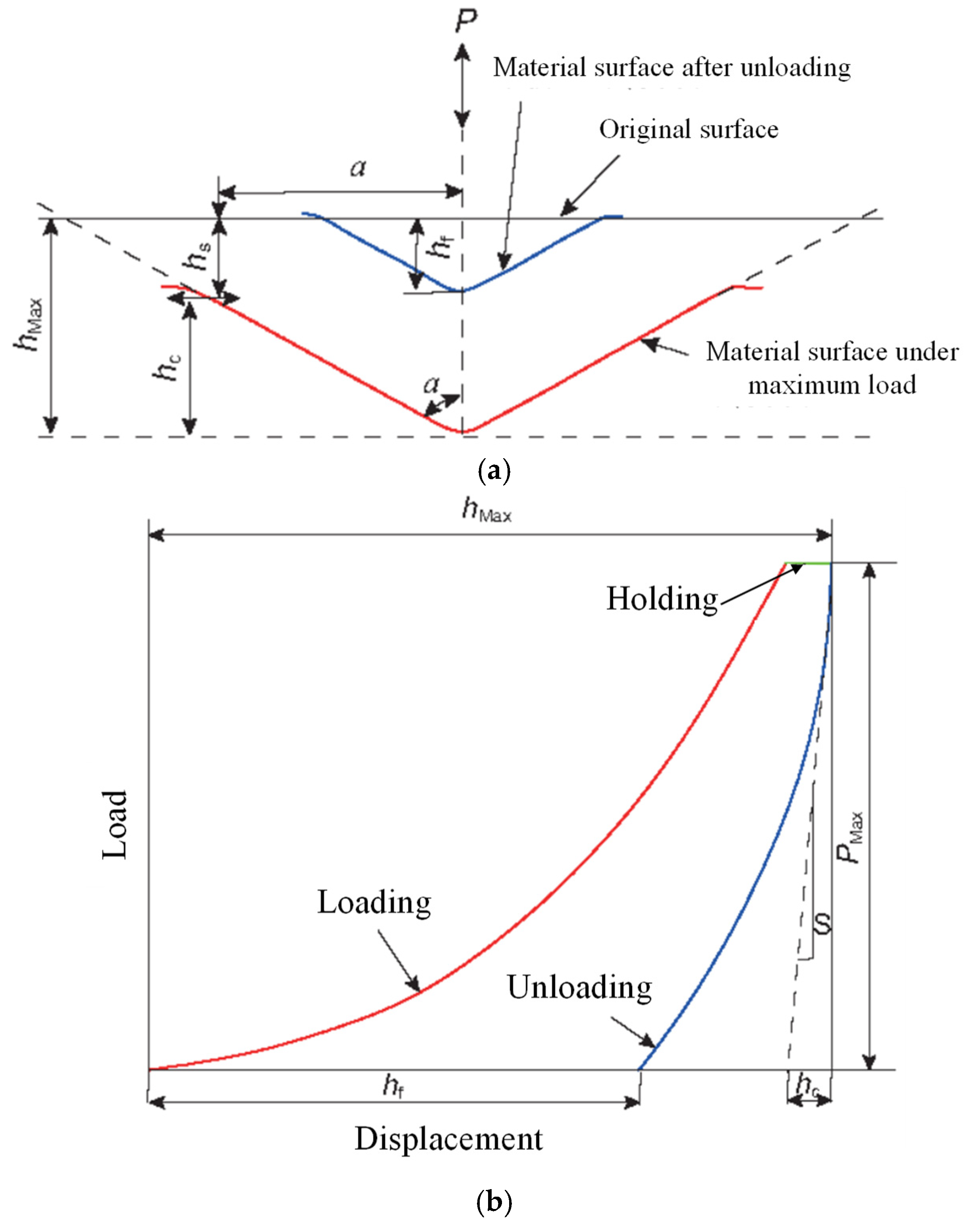
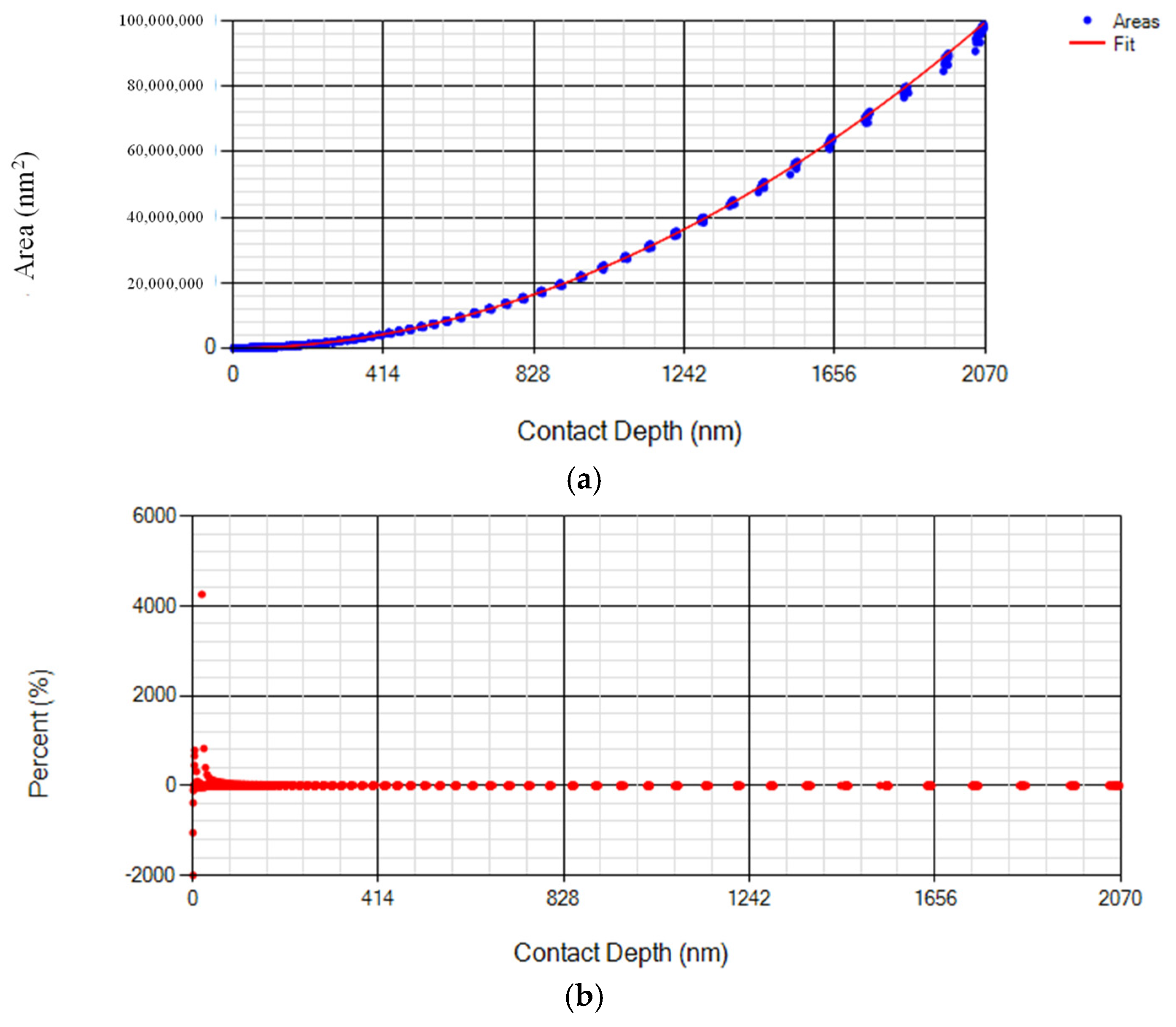

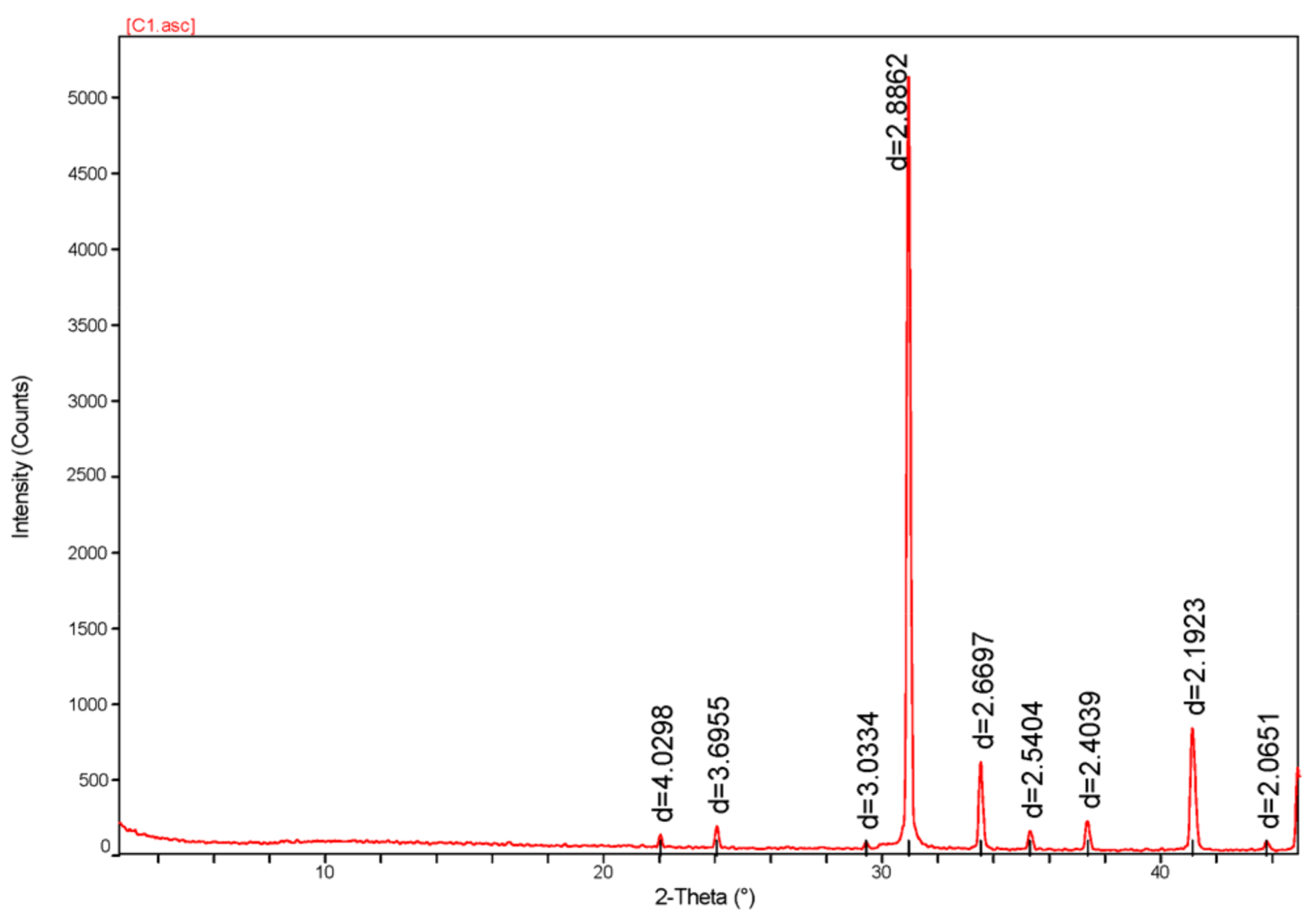
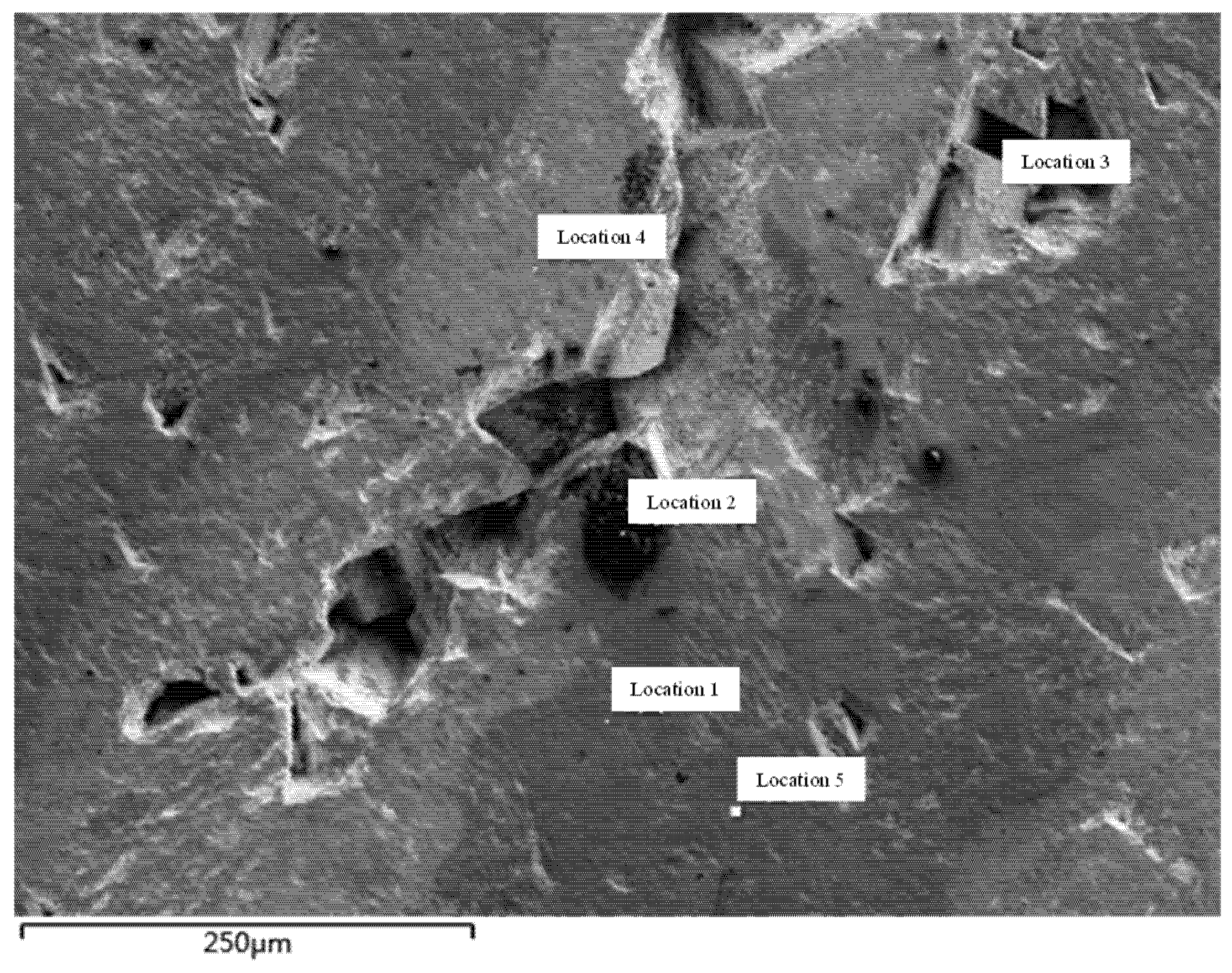

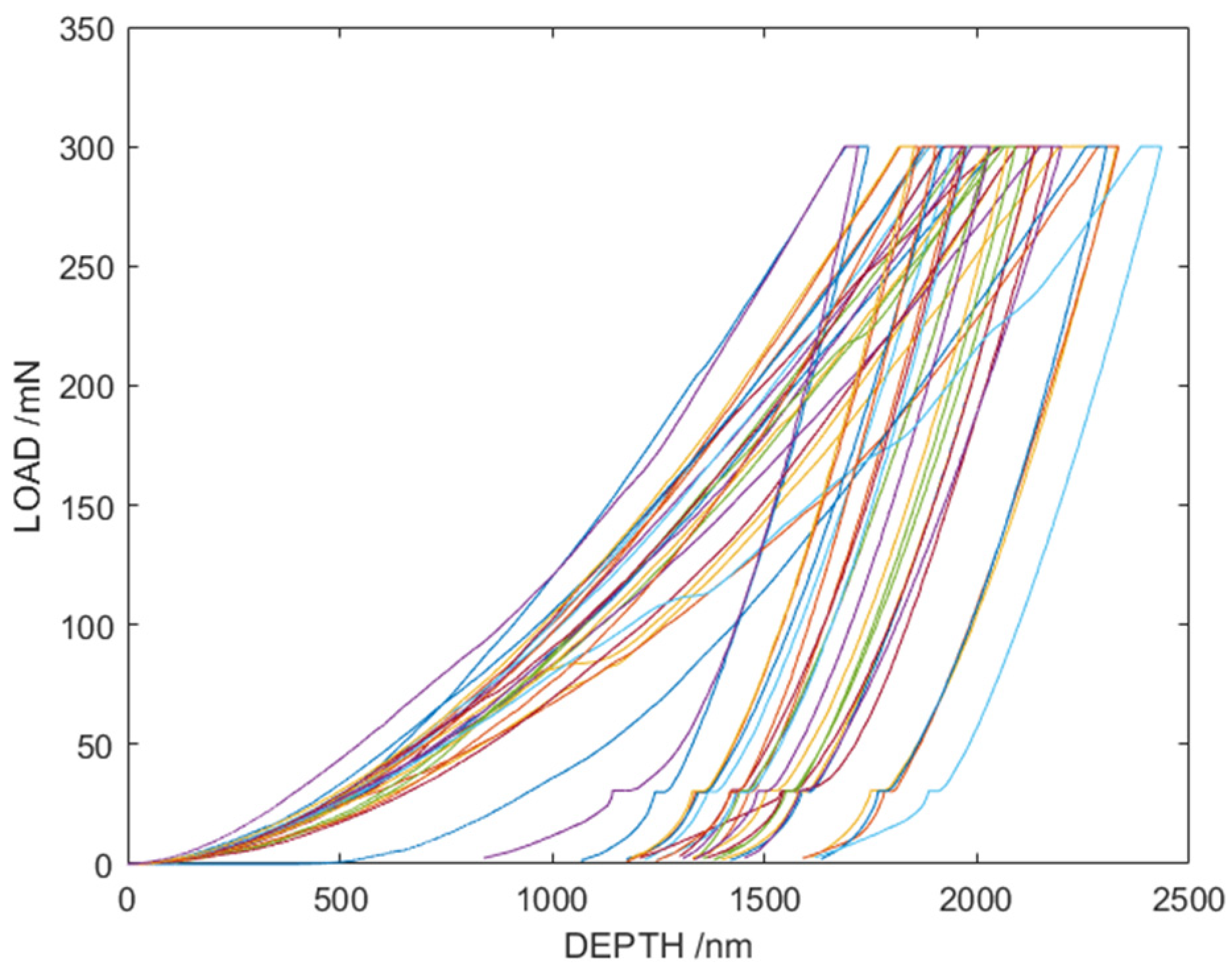


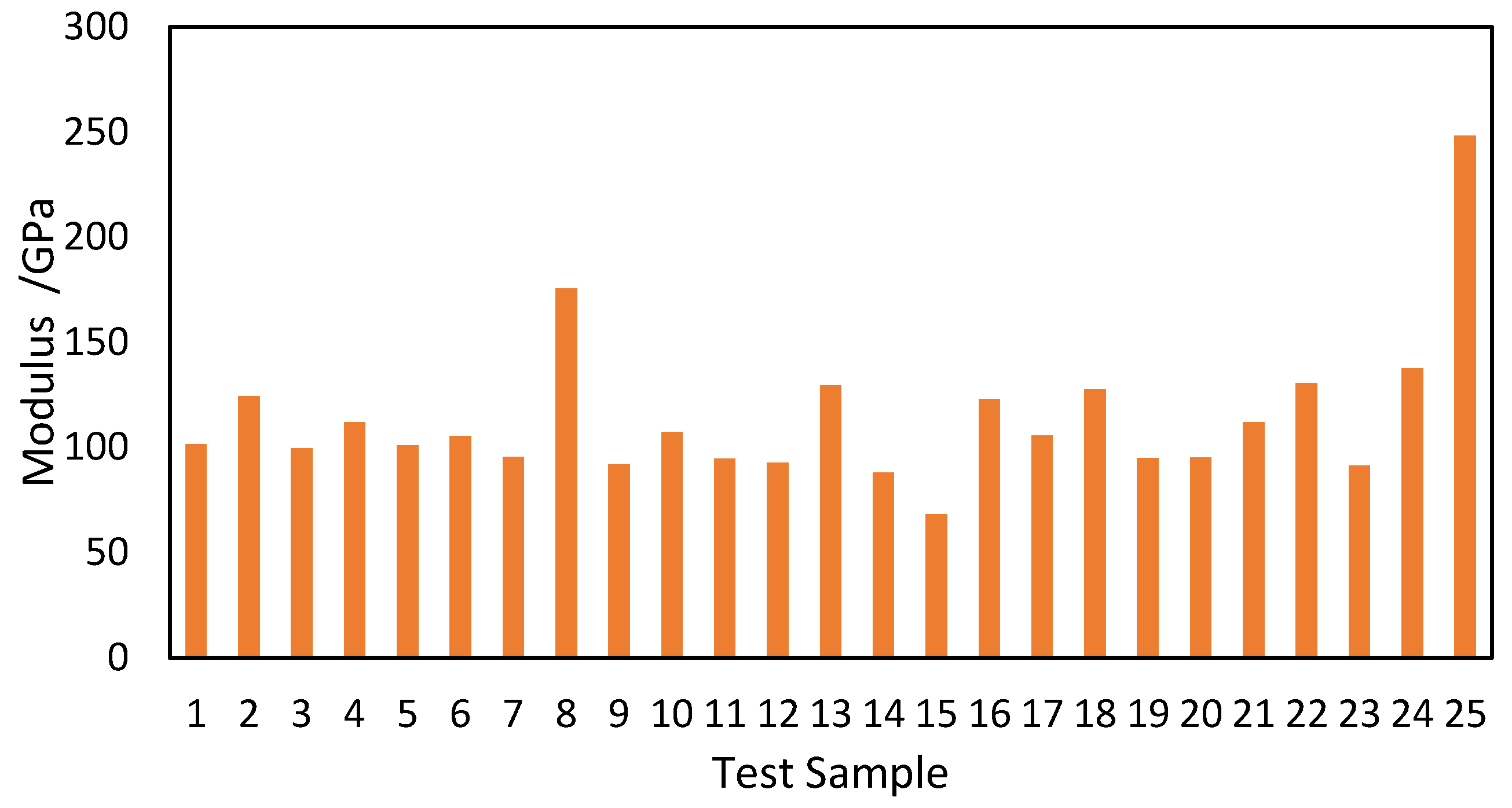


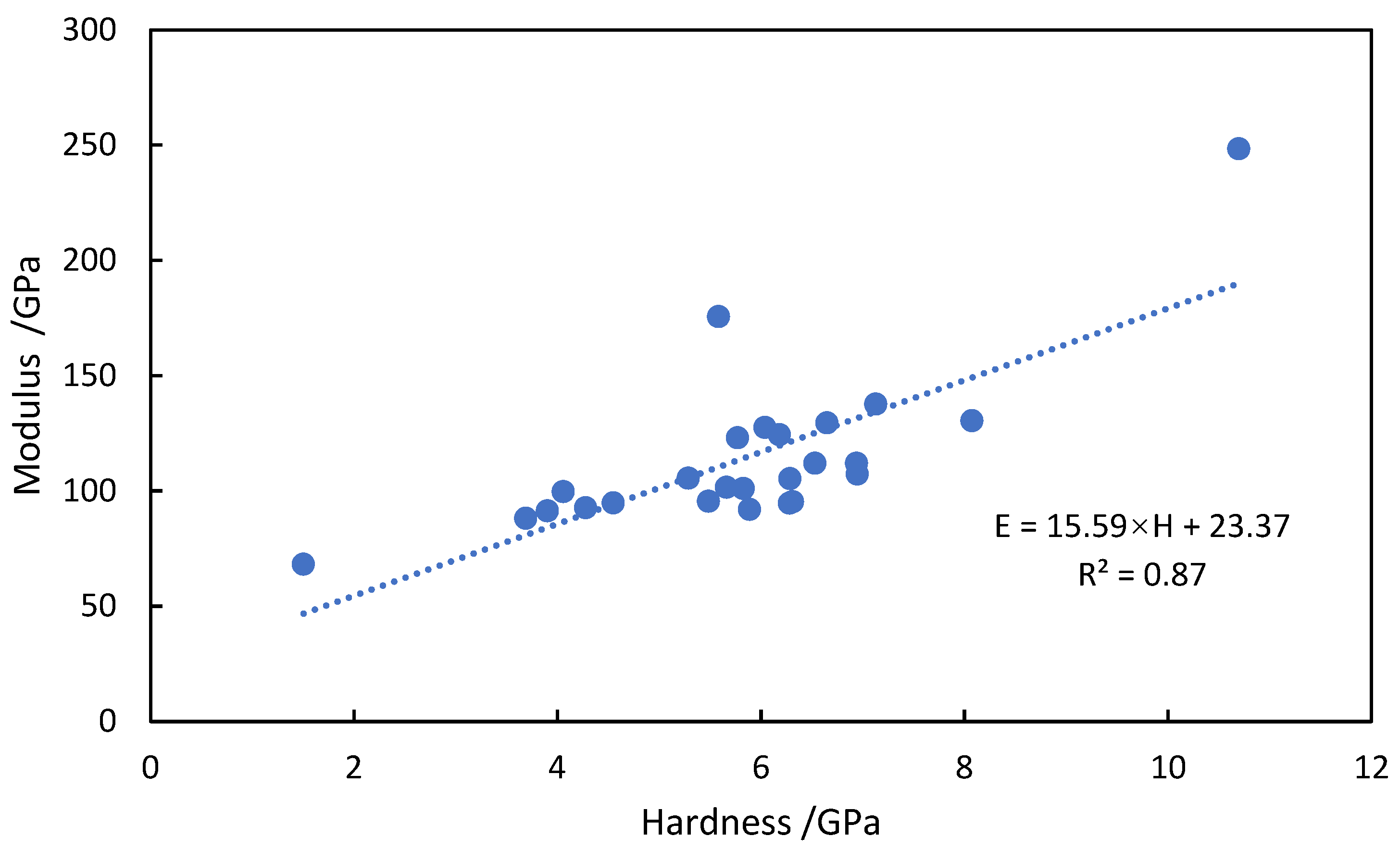


| Parameters | C0 | C1 | C2 | C3 | C4 |
|---|---|---|---|---|---|
| Value | 22.62 | 1979.67 | −51,379.45 | 211,172.66 | −169,209.36 |
| Observed d-Spacing/Å | Matched Compound (PDF Card) | Miller Indices/hkl | Space Group | Crystallite Size/nm |
|---|---|---|---|---|
| 4.0298 | SiO2 (00-046-1045) | −100 | P3221 | ~25 nm |
| 3.6955 | Al2O3 (00-010-0173) | −104 | R-3c | ~18 nm |
| 3.0334 | Fe3O4 (01-088-0315) | −311 | Fd-3m | ~32 nm |
| 2.6697 | CaCO3 (01-086-2334) | −104 | R-3c | ~40 nm |
| 2.5404 | TiO2 (01-076-0320) | −101 | P42/mnm | ~28 nm |
| 2.4039 | Al (00-004-0787) | −111 | Fm-3m | ~50 nm |
| 2.1923 | Fe (00-006-0696) | −110 | Im-3m | ~45 nm |
| 2.0651 | Graphite (00-041-1487) | −2 | P63/mmc | ~15 nm |
| Samples | Mineral Composition | |
|---|---|---|
| Calcite/% | Dolomite/% | |
| 1-1 | 0.6 | 99.4 |
| 2-1 | 1.0 | 99.0 |
| 3-1 | 7.3 | 92.7 |
| 4-1 | 1.3 | 98.7 |
| 5-1 | 1.5 | 98.5 |
| 6-1 | 2.1 | 97.9 |
| Location | Element | |||
|---|---|---|---|---|
| O/% | Ca/% | Mg/% | C/% | |
| Location 1 | 46.5 | 22 | 17.3 | 14.2 |
| Location 2 | 51.6 | 9.8 | 11.4 | 27.2 |
| Location 3 | 51.0 | 10.0 | 12.6 | 26.3 |
| Location 4 | 55.8 | 11.0 | 22.4 | 10.8 |
| Location 5 | 59.0 | 10.2 | 19.8 | 11.0 |
| Samples | Mean Micro-Mechanical Parameters | ||
|---|---|---|---|
| Maximum Indentation Depth/nm | Hardness/GPa | Elastic Modulus/GPa | |
| 1-1 | 2057.3 | 5.82 | 114.12 |
| 2-1 | 2040.0 | 5.43 | 118.67 |
| 3-1 | 1948.0 | 6.03 | 123.11 |
| 4-1 | 1977.2 | 5.88 | 113.41 |
| 5-1 | 2006.0 | 6.23 | 128.05 |
Disclaimer/Publisher’s Note: The statements, opinions and data contained in all publications are solely those of the individual author(s) and contributor(s) and not of MDPI and/or the editor(s). MDPI and/or the editor(s) disclaim responsibility for any injury to people or property resulting from any ideas, methods, instructions or products referred to in the content. |
© 2025 by the authors. Licensee MDPI, Basel, Switzerland. This article is an open access article distributed under the terms and conditions of the Creative Commons Attribution (CC BY) license (https://creativecommons.org/licenses/by/4.0/).
Share and Cite
Zheng, M.; Gu, Z.; Dong, H.; Ma, T.; Wu, Y. Nanoindentation-Based Characterization of Mesoscale Mechanical Behavior in Dolomite Crystals. Processes 2025, 13, 1203. https://doi.org/10.3390/pr13041203
Zheng M, Gu Z, Dong H, Ma T, Wu Y. Nanoindentation-Based Characterization of Mesoscale Mechanical Behavior in Dolomite Crystals. Processes. 2025; 13(4):1203. https://doi.org/10.3390/pr13041203
Chicago/Turabian StyleZheng, Majia, Zhiwen Gu, Hao Dong, Tinghu Ma, and Ya Wu. 2025. "Nanoindentation-Based Characterization of Mesoscale Mechanical Behavior in Dolomite Crystals" Processes 13, no. 4: 1203. https://doi.org/10.3390/pr13041203
APA StyleZheng, M., Gu, Z., Dong, H., Ma, T., & Wu, Y. (2025). Nanoindentation-Based Characterization of Mesoscale Mechanical Behavior in Dolomite Crystals. Processes, 13(4), 1203. https://doi.org/10.3390/pr13041203





